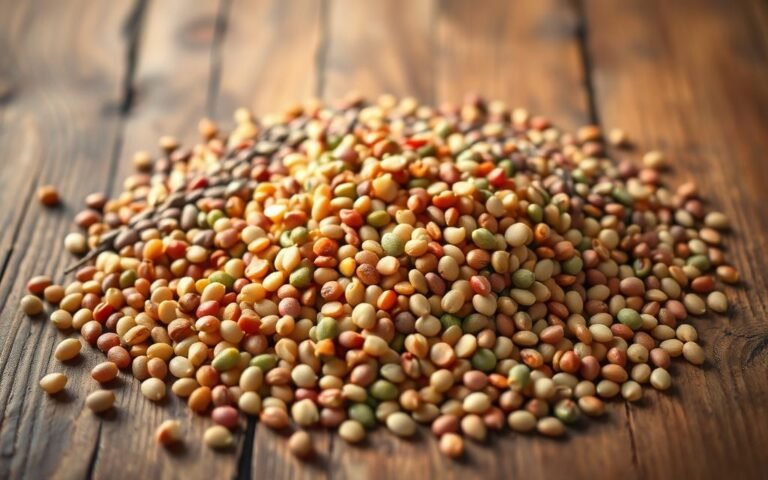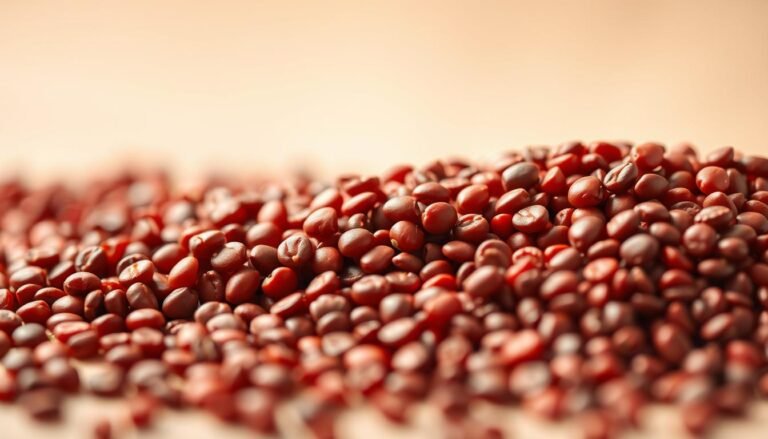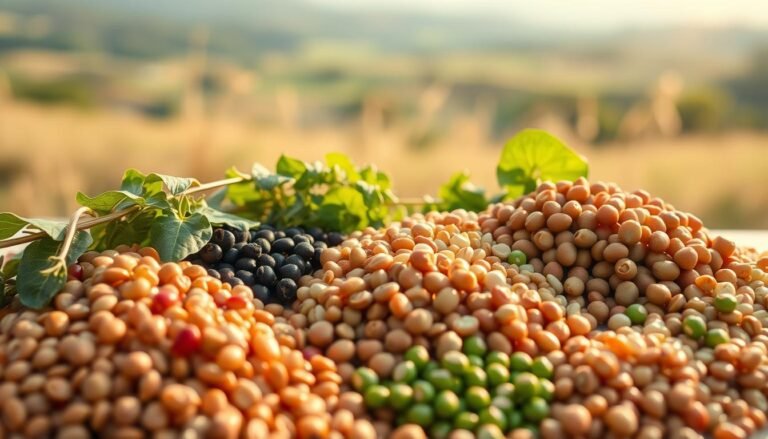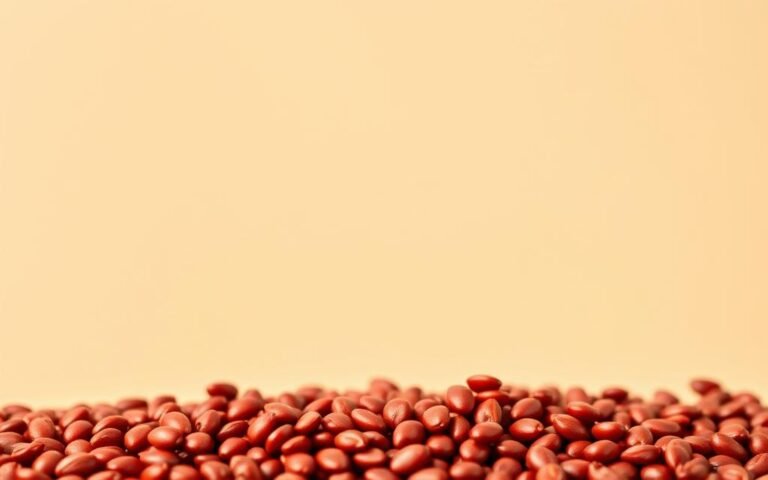Red lentils whole are a nutritious and versatile ingredient, perfect for incorporating into your daily meals. Rich in protein, fiber, and essential minerals, they offer a multitude of health benefits.
Cooking with red lentils is straightforward and rewarding. They can be added to a variety of dishes, from soups and stews to curries and salads, enhancing both the nutritional value and flavor.
Whether you’re a seasoned cook or just starting to explore the world of legumes, red lentils whole are an excellent addition to your pantry. They are easy to cook and pair well with a wide range of spices and ingredients.
Key Takeaways
- Red lentils are rich in protein and fiber.
- They are versatile and can be used in various dishes.
- Cooking with red lentils is easy and rewarding.
- Red lentils whole are a great pantry staple.
- They offer numerous health benefits when included in daily meals.
What Are Red Lentils Whole? Understanding This Versatile Legume
Red lentils, available in whole form, are a nutritious and versatile legume. They are a staple in many cuisines around the world, particularly in Indian and Middle Eastern cooking. Whole red lentils have a slightly different texture and cooking time compared to their split counterparts, making them suitable for a variety of dishes.
The Difference Between Split and Whole Red Lentils
The primary difference between split and whole red lentils lies in their processing and cooking characteristics. Whole red lentils are less processed, retaining their outer skin, which makes them hold their shape better during cooking. In contrast, split red lentils (often labeled as ‘masoor dal’) are more processed, with their outer skin removed, resulting in a softer texture and quicker cooking time. This difference allows cooks to choose between the two forms based on the desired texture and cooking time for their recipes.
Varieties of Red Lentils Available in Australia
In Australia, consumers can find various types of red lentils, including those labeled as ‘masoor dal.’ These lentils are often sourced from countries like India and Canada. The availability of different varieties allows Australian cooks to experiment with a range of recipes, from traditional Indian dals to hearty soups and stews. When shopping for red lentils whole, it’s essential to check the packaging for information on the origin and type to ensure you’re getting the desired quality and variety for your cooking needs.
Nutritional Profile: Health Benefits of Red Lentils
Red lentils are an incredibly nutritious food, offering a multitude of health benefits. They are a staple in many cuisines around the world, particularly in Australian cooking, due to their versatility and nutritional value.
Protein and Fiber Content
Red lentils are rich in both protein and fiber, making them an excellent choice for vegetarians and vegans. With approximately 26 grams of protein per 100 grams, they are an ideal protein source. The high fiber content, about 7.9 grams per 100 grams, aids in digestion and satiety.
Essential Vitamins and Minerals
Red lentils are a good source of essential vitamins and minerals, including iron, folate, and potassium. Iron is crucial for healthy red blood cells, while folate is important for cell division and growth. Potassium helps maintain healthy blood pressure.
| Nutrient | Amount per 100g | % Daily Value |
|---|---|---|
| Protein | 26g | 52% |
| Fiber | 7.9g | 32% |
| Iron | 3.9mg | 22% |
| Folate | 181mcg | 45% |
How Red Lentils Support Australian Dietary Guidelines
Red lentils align with Australian dietary guidelines by providing a rich source of plant-based protein and fiber. They are recommended as part of a balanced diet that includes a variety of vegetables, fruits, and whole grains. Incorporating red lentils into meals can help Australians meet their daily nutritional needs.
Buying and Storing Red Lentils Whole
Red lentils whole are a pantry staple that can be easily sourced from various outlets in Australia. Whether you’re a seasoned cook or just starting to explore the world of lentils, knowing where to buy and how to store them is essential for making the most of this versatile ingredient.
Best Places to Source Quality Red Lentils in Australia
In Australia, you can find red lentils whole in most health food stores and supermarkets. Specialty stores like Whole Foods and Health Food Store often carry a variety of red lentils, including organic and bulk options. For those looking for convenience, online retailers like Amazon Australia and Coles Online offer a wide selection.
Bulk Buying Tips for Cost Efficiency
Buying red lentils whole in bulk can be a cost-effective strategy, especially for frequent users. When purchasing in bulk, ensure you’re buying from a reputable supplier to guarantee quality. Consider the following table for bulk buying guidelines:
| Quantity | Price per Kilogram | Total Cost |
|---|---|---|
| 1 kg | $2.50 | $2.50 |
| 5 kg | $2.00 | $10.00 |
| 10 kg | $1.80 | $18.00 |
Proper Storage Methods for Maximum Shelf Life
To maintain the quality of red lentils whole, proper storage is crucial. Store them in a cool, dry place, away from direct sunlight. Airtight containers are ideal for keeping lentils fresh. For long-term storage, consider using mylar bags or glass jars with tight-fitting lids.
Essential Preparation Techniques for Whole Red Lentils
To get the most out of whole red lentils, proper preparation is key. Whether you’re a seasoned cook or just starting out, understanding how to prepare your lentils can make a significant difference in the final dish.
Sorting and Cleaning Methods
Before cooking, it’s crucial to sort and clean your whole red lentils. Spread them out on a flat surface and remove any debris, stones, or shriveled lentils. Rinsing the lentils under cold running water can also help remove any impurities. This simple step ensures your lentils cook evenly and taste their best.
Soaking: When Necessary and How Long
Soaking whole red lentils is not always necessary, but it can reduce cooking time. If you choose to soak, a few hours or overnight should suffice. Some cooks find that soaking helps with digestibility. However, if you’re short on time, you can skip this step without significantly impacting the final result.
Pre-cooking Considerations for Best Results
Before cooking, give your lentils a final rinse. The ratio of lentils to water is also important; generally, a 2:1 water-to-lentil ratio is recommended. Be mindful of the salt addition; it’s best to add salt towards the end of cooking to prevent the lentils from becoming tough.
Key Preparation Tips:
- Sort and clean lentils before cooking
- Soak lentils if you want to reduce cooking time
- Rinse lentils before cooking
- Use the right water-to-lentil ratio
- Add salt towards the end of cooking
By following these preparation techniques, you’ll be well on your way to cooking delicious and nutritious whole red lentils. Experiment with different recipes and enjoy the versatility this ingredient has to offer.

Basic Cooking Methods for Red Lentils
The simplicity of cooking red lentils makes them an ideal ingredient for a variety of dishes. Whether you’re preparing a hearty soup, a flavorful curry, or a nutritious salad, understanding the different cooking methods can enhance your culinary experience. Red lentils can be cooked using various techniques, each with its own advantages.
Stovetop Simmering: The Traditional Approach
Stovetop simmering is a traditional and straightforward method for cooking red lentils. It involves rinsing the lentils, then boiling them in water or broth, followed by a gentle simmer until they are tender. This method allows for easy monitoring of the lentils’ texture and flavor. To enhance flavor, aromatics like onions, garlic, and spices can be added to the pot. Typically, red lentils take about 20-25 minutes to cook on the stovetop, making it a relatively quick method.
Pressure Cooker and Instant Pot Methods
For those short on time, using a pressure cooker or Instant Pot can significantly reduce the cooking time for red lentils. These appliances can cook lentils in under 10 minutes, preserving nutrients and flavor. The process involves adding lentils and liquid to the cooker, setting the appropriate pressure and time, and letting the machine do the work. This method is not only fast but also energy-efficient, making it an attractive option for busy households.
Slow Cooker Technique for Busy Days
The slow cooker is another excellent option for cooking red lentils, ideal for busy days when you want to come home to a ready meal. Simply add rinsed lentils, your choice of broth or water, and any desired spices or vegetables to the slow cooker. Cooking on low for 6-8 hours or high for 3-4 hours allows the flavors to meld together, resulting in a tender and flavorful dish.
| Cooking Method | Cooking Time | Benefits |
|---|---|---|
| Stovetop Simmering | 20-25 minutes | Easy to monitor texture and flavor |
| Pressure Cooker/Instant Pot | Under 10 minutes | Quick, nutrient-preserving, energy-efficient |
| Slow Cooker | 6-8 hours (low), 3-4 hours (high) | Convenient for busy days, rich flavor development |
Hearty Soups and Stews Using Red Lentils Whole
Red lentils whole are the unsung heroes of Australian cooking, providing the base for a variety of delicious and comforting soups and stews. Their high protein and fiber content make them an ideal ingredient for creating nutritious meals that are both filling and flavorful.
Classic Australian Red Lentil Soup Recipe
A classic Australian red lentil soup is a staple in many households. To make it, start by sautéing onions, carrots, and celery in olive oil, then add red lentils whole, diced tomatoes, and vegetable broth. Season with salt, pepper, and a hint of cumin. Simmer until the lentils are tender, then serve with a swirl of cream and crusty bread.
| Ingredient | Quantity |
|---|---|
| Red lentils whole | 1 cup |
| Onion | 1 medium |
| Carrots | 2 medium |
| Celery | 2 stalks |
| Diced tomatoes | 1 can |
| Vegetable broth | 4 cups |
Spiced Red Lentil Stew with Seasonal Vegetables
For a spiced red lentil stew, sauté onions, ginger, and garlic, then add a blend of warming spices like cumin, coriander, and turmeric. Add red lentils whole, seasonal vegetables (such as sweet potatoes and zucchini), and a can of diced tomatoes. Simmer in broth until the lentils and vegetables are tender. Serve with a dollop of yogurt and a sprinkle of fresh herbs.
“The beauty of red lentils whole lies in their versatility and ability to absorb flavors, making them perfect for a variety of soup and stew recipes.”
Creamy Coconut Red Lentil Soup
For a creamy coconut red lentil soup, start by cooking red lentils whole in coconut milk and vegetable broth. Add sautéed onions, ginger, and a touch of curry powder for depth of flavor. Blend until smooth, then season with salt and a squeeze of lime juice. Garnish with toasted coconut flakes and fresh cilantro.
These recipes showcase the versatility of red lentils whole in creating hearty, comforting soups and stews that are perfect for any time of the year. Whether you’re in the mood for a classic lentil soup or something more exotic, red lentils whole are sure to become a staple in your kitchen.
Red Lentils in Main Dishes: Everyday Dinner Ideas
Incorporating red lentils into main dishes can elevate everyday meals with their rich nutritional profile and versatility. These lentils are an excellent source of protein and fiber, making them a great addition to a variety of cuisines.
Red Lentil Curry with Australian Spices
A flavorful and aromatic curry can be made by combining red lentils with Australian spices, creating a dish that’s both comforting and exotic. This curry is perfect for a weeknight dinner and can be served with rice or naan bread. For more red lentil recipe ideas, visit BBC Good Food’s red lentil recipes.
Plant-Based Lentil Bolognese
For a meatless twist on the classic Italian sauce, red lentils can be used to create a hearty and satisfying bolognese. This plant-based version is not only delicious but also packed with nutrients, making it a great option for a family dinner.
Stuffed Vegetables with Red Lentil Filling
Red lentils can be used as a filling in stuffed vegetables, adding protein and texture to this colorful dish. By mixing cooked lentils with spices and herbs, you can create a flavorful filling that’s perfect for bell peppers, zucchini, or eggplant.
These main dishes showcase the versatility of red lentils in everyday cooking. Whether you’re making a curry, a pasta sauce, or stuffed vegetables, red lentils are a great ingredient to have in your pantry.
Hearty Soups and Stews Using Red Lentils Whole
When it comes to comforting meals, whole red lentils are a versatile choice for soups and stews that warm the soul. These nutritious legumes not only add protein and fiber but also absorb flavors beautifully, making them a perfect base for a variety of dishes.
Nutritional Benefits of incorporating red lentils whole into your soups and stews include a boost in protein, fiber, and essential vitamins and minerals. They are particularly beneficial for those looking for plant-based protein sources.
There are several cooking methods you can employ when preparing soups and stews with red lentils. The traditional stovetop simmering method allows for a rich flavor development, while using a pressure cooker or Instant Pot can significantly reduce cooking time.

Some popular soup and stew recipes that feature red lentils whole include a classic Australian red lentil soup, spiced red lentil stew with seasonal vegetables, and creamy coconut red lentil soup. These recipes not only showcase the versatility of red lentils but also highlight their ability to blend with various flavors.
To make the most of your soups and stews, consider the following tips:
- Sort and clean the lentils before cooking to remove any debris.
- Adjust the seasoning according to the type of stew or soup you’re making.
- Experiment with different spices and herbs to add unique flavors.
By incorporating red lentils whole into your meal prep, you can enjoy a range of hearty and healthy soups and stews that are perfect for any time of the year.
Fresh Approaches: Red Lentils in Salads and Side Dishes
Red lentils whole are not just for soups and stews; they can also be the star of refreshing salads and delicious side dishes. Their nutritional profile and versatility make them an excellent addition to a variety of meals.
Cold Lentil Salad for Australian Summers
A cold lentil salad is perfect for hot Australian summers. Simply cook the red lentils whole, let them cool, and mix with diced vegetables like cucumbers, tomatoes, and red onions. Add a dressing of your choice, such as a lemon-tahini vinaigrette, to bring everything together.
Warm Lentil Side Dish with Roasted Vegetables
For a hearty side dish, combine cooked red lentils whole with roasted vegetables like carrots, zucchini, and bell peppers. Season with herbs such as thyme and rosemary for a flavorful and nutritious accompaniment to your main course.
Mediterranean-Inspired Lentil Tabbouleh
Transform the classic tabbouleh into a protein-packed side by incorporating red lentils whole. Mix cooked lentils with chopped parsley, tomatoes, mint, and a squeeze of lemon juice. This refreshing salad is perfect for a light and healthy meal.
By incorporating red lentils whole into your salads and side dishes, you can add variety, nutrition, and flavor to your meals. Experiment with different ingredients and seasonings to create dishes that suit your taste preferences.
Starting the Day Right: Breakfast Ideas with Red Lentils
Red lentils are a versatile ingredient that can transform your breakfast into a hearty, healthy meal. Incorporating them into your morning routine not only adds protein and fiber but also provides a delicious twist on traditional breakfast dishes.
Red Lentil Porridge with Australian Fruits
A warm and comforting breakfast option is a red lentil porridge, especially when topped with seasonal Australian fruits. To make it, simply cook red lentils with milk or a milk alternative, add a sweetener like honey, and top with fruits such as berries or sliced bananas.
Nutritional Benefits: This porridge is not only filling but also packed with fiber and protein, making it an ideal breakfast for a busy day.
Savory Breakfast Bowl with Lentils and Eggs
For those who prefer a savory breakfast, a bowl made with cooked red lentils, topped with poached eggs, and garnished with fresh herbs is a great option. This dish is a powerhouse of nutrition, combining the protein from both the lentils and eggs.
Tips for Preparation: Cook the red lentils ahead of time and store them in the fridge for up to three days to make this breakfast quick to assemble.
Protein-Rich Lentil Pancakes
Red lentils can also be used to make protein-rich pancakes. By blending cooked lentils with flour, eggs, and spices, you can create a batter that cooks into fluffy, nutritious pancakes.
| Breakfast Idea | Main Ingredients | Nutritional Highlights |
|---|---|---|
| Red Lentil Porridge | Red lentils, milk, honey, Australian fruits | High in fiber, protein, and vitamins |
| Savory Lentil Breakfast Bowl | Red lentils, eggs, fresh herbs | Rich in protein, fiber, and minerals |
| Lentil Pancakes | Red lentils, flour, eggs, spices | Good source of protein, fiber, and complex carbohydrates |
These breakfast ideas showcase the versatility of red lentils in creating nutritious and delicious morning meals. Whether you prefer something sweet like porridge or savory like a lentil and egg bowl, red lentils are a fantastic addition to your breakfast repertoire.
Unexpected Uses: Baking with Red Lentils
Incorporating red lentils into your baking can add nutrition and texture to your treats. Red lentils whole can be used to create flour, enhance existing recipes, or form the base of new baked goods. This versatility makes them an excellent addition to any baker’s pantry.
Making and Using Red Lentil Flour
To make red lentil flour, simply grind whole red lentils in a high-speed blender or food processor until you achieve a fine powder. Sifting the flour can help remove any lumps and ensure a smooth texture in your baked goods. Red lentil flour is high in protein and fiber, making it a nutritious alternative to traditional flours.
When using red lentil flour in recipes, it’s essential to note that it absorbs more liquid than traditional flour. You may need to adjust the liquid content in your recipe accordingly. Start by adding a small amount of extra liquid and gradually increase it until you achieve the desired consistency.
Healthier Treats: Lentil Brownies and Blondies
Adding red lentils to your favorite brownie or blondie recipe can significantly enhance their nutritional profile. The lentils blend into the batter, adding moisture and a subtle depth of flavor. To incorporate red lentils, cook and puree them before adding them to your recipe.
| Recipe | Lentil Addition | Nutritional Benefit |
|---|---|---|
| Brownies | 1/2 cup cooked red lentils | Added protein and fiber |
| Blondies | 1/2 cup cooked red lentils | Enhanced moisture and nutrition |
Bread and Crackers with Red Lentil Base
Red lentils can also be used to make delicious and nutritious bread and crackers. By mixing cooked lentils with flour and other ingredients, you can create a dough that bakes into a tasty and healthy snack.
For crackers, combine red lentil flour with water, a pinch of salt, and your choice of herbs or spices. Roll out the dough thinly and cut into desired shapes before baking until crispy.
Experimenting with red lentils in baking not only adds variety to your recipes but also boosts their nutritional value. Whether you’re making flour, brownies, or crackers, red lentils whole are a versatile ingredient that can elevate your baking.
Global Flavors: Red Lentils in International Cuisines
Whole red lentils are used in diverse culinary traditions around the world, showcasing their adaptability and nutritional value. This versatility has made them a staple in many global cuisines, from hearty stews to fresh salads.
Indian Dal Recipes Using Whole Red Lentils
Indian cuisine is renowned for its rich and varied use of lentils, with red lentils being a key ingredient in many dal recipes. Dal makhani, a popular Punjabi dish, combines red lentils with black lentils and spices for a creamy, comforting meal. Another favorite is masoor dal, a simple yet flavorful red lentil curry that’s often served with rice or roti.
| Recipe | Main Ingredients | Flavor Profile |
|---|---|---|
| Dal Makhani | Red lentils, black lentils, tomatoes, butter | Rich, creamy, slightly spicy |
| Masoor Dal | Red lentils, onions, garlic, turmeric | Light, aromatic, mildly spiced |
Middle Eastern Lentil Dishes Popular in Australia
In Middle Eastern cuisine, red lentils are often used in soups and stews, adding protein and texture. Shurpa, a traditional Central Asian soup, features red lentils along with vegetables and sometimes meat, making for a nourishing meal. Another dish, red lentil kofta, showcases the lentils’ versatility in a meatball-like preparation, often served with a tangy yogurt sauce.
- Shurpa: A hearty soup with red lentils, vegetables, and sometimes meat.
- Red Lentil Kofta: Lentil-based meatballs, often served with yogurt sauce.
Mediterranean Lentil Preparations
The Mediterranean region also incorporates red lentils into its cuisine, often in salads and side dishes. A Greek lentil salad might include red lentils, tomatoes, cucumbers, and a zesty dressing, perfect for a light lunch. Additionally, lentil pilaf is a flavorful side dish made with red lentils, rice, and spices, often served alongside grilled meats or vegetables.
- Prepare red lentils according to package instructions.
- Mix cooked lentils with diced vegetables and a simple vinaigrette for a salad.
- For a pilaf, sauté onions and spices, then add lentils and rice, cooking until tender.
By exploring these global flavors, home cooks can discover new ways to incorporate red lentils into their meals, benefiting from their nutritional value and culinary versatility.
Time-Saving Strategies: Meal Prepping with Red Lentils
Meal prepping with red lentils is a game-changer for busy Australians looking to save time without sacrificing nutrition. Red lentils are ideal for meal prep due to their versatility and nutritional value. By incorporating batch cooking, freezing, and storing cooked lentils into your routine, you can simplify your weekly cooking tasks and ensure healthy meals.
Batch Cooking Basics for Busy Australians
Batch cooking is a fundamental aspect of meal prep, and red lentils are perfectly suited for this approach. To get started, cook a large batch of lentils with some onions, garlic, and your choice of spices. This base can then be used in various dishes throughout the week.
- Cook a large batch of red lentils once a week.
- Use this base in different recipes, such as curries, stews, and salads.
- Portion out individual servings for easy grab-and-go meals.
Freezing and Storing Cooked Lentils
Freezing cooked lentils is an excellent way to extend their shelf life and have a quick protein source ready whenever needed. To freeze, let the cooked lentils cool completely, then transfer them to airtight containers or freezer bags.
Tips for Freezing:
- Label containers with the date and contents.
- Store in the freezer for up to 3 months.
- Thaw overnight in the fridge or reheat directly from frozen.
Quick Weeknight Meals from Prepared Lentils
Having pre-cooked lentils on hand makes it easy to whip up a nutritious meal in no time. Here are some ideas for quick weeknight meals:
- Lentil curry with rice or roti.
- Lentil soup with a swirl of cream or crusty bread.
- Salads with lentils, mixed vegetables, and a tangy dressing.
By incorporating these time-saving strategies into your meal prep routine, you can enjoy the benefits of red lentils while saving time and reducing cooking stress. Whether you’re a busy professional or a parent on-the-go, meal prepping with red lentils is a simple and effective way to maintain a healthy diet.
Troubleshooting: Common Mistakes When Cooking Red Lentils Whole
Red lentils are a versatile ingredient, but achieving the right texture and flavor requires avoiding some common pitfalls. Understanding these mistakes and how to correct them can significantly improve your cooking results.
Texture Problems and How to Avoid Them
One of the most common issues with cooking red lentils is achieving the right texture. Overcooking can lead to mushiness, while undercooking results in lentils that are too firm.
- Overcooking: To avoid mushy lentils, monitor the cooking time closely. Generally, whole red lentils take about 20-25 minutes to cook on the stovetop.
- Undercooking: If lentils are not cooked long enough, they can remain hard. Ensure you’ve soaked them appropriately before cooking, if soaking is chosen.
Seasoning Errors and Flavor Corrections
Seasoning is crucial for bringing out the flavor in red lentils. A common mistake is not seasoning adequately or at the right time.
| Seasoning Tip | Benefit |
|---|---|
| Season at the beginning and end | Builds depth of flavor and enhances final taste |
| Avoid adding salt too early | Prevents lentils from becoming tough |
| Use aromatics like onions and garlic | Adds complexity to the dish |
Pairing Mistakes with Other Ingredients
Red lentils can be paired with a variety of ingredients, but some combinations work better than others. Understanding how to pair them effectively can elevate your dishes.
- Vegetables: Pairing lentils with roasted or sautéed vegetables can add texture and flavor contrast.
- Spices: Using the right spices can complement the earthy flavor of lentils. For example, cumin and coriander are classic pairings in many cuisines.
By being aware of these common mistakes and taking steps to avoid them, you can improve your cooking with red lentils and enjoy a variety of delicious, nutritious meals.
Beyond Cooking: Sustainable Benefits of Red Lentils
Red lentils whole offer more than just a meal; they contribute to a sustainable future. As Australians increasingly look for ways to reduce their environmental footprint, incorporating red lentils into their diet can make a significant difference.
Environmental Impact of Lentil Farming in Australia
Lentil farming in Australia has a positive environmental impact. Red lentils whole require less water compared to other protein sources, making them a more sustainable option. Additionally, lentil crops help improve soil health by fixing nitrogen, reducing the need for synthetic fertilizers.
The cultivation of lentils also supports biodiversity by providing a break in cereal cropping systems, enhancing ecosystem services, and promoting a more balanced agricultural environment.
Economic Benefits of Plant-Based Protein Sources
Choosing plant-based protein sources like red lentils whole can have significant economic benefits. By supporting local farmers who grow lentils, Australians can contribute to the local economy. Moreover, plant-based diets tend to be less resource-intensive, potentially reducing healthcare costs associated with diet-related illnesses.
The demand for plant-based proteins is on the rise, and by investing in crops like lentils, farmers can diversify their income streams and improve the resilience of their businesses.
Reducing Food Waste with Versatile Lentils
Red lentils whole are incredibly versatile, allowing them to be used in a variety of dishes, from soups to salads, and even baked goods. This versatility helps reduce food waste by enabling consumers to use lentils in multiple meals, minimizing the likelihood of ingredients going to waste.
By incorporating red lentils into meal planning, Australians can not only enhance their nutritional intake but also contribute to a more sustainable food system.
Conclusion: Embracing Red Lentils as a Kitchen Essential
Red lentils whole are a versatile, nutritious, and sustainable ingredient that can elevate your daily cooking. Throughout this article, we’ve explored the various benefits and uses of red lentils, from their nutritional profile to their culinary applications.
Cooking with red lentils whole opens up a world of possibilities, from hearty soups and stews to innovative salads and side dishes. By incorporating red lentils into your meal prep, you can enjoy a range of health benefits while reducing your environmental impact.
As you’ve discovered, red lentils are easy to prepare and can be used in a variety of cuisines, from Indian and Middle Eastern to Mediterranean and Australian. Whether you’re a busy home cook or an adventurous foodie, red lentils whole are a valuable addition to any kitchen.
Start exploring the world of red lentils today and experience the benefits of cooking with this incredible ingredient. With its numerous health benefits, culinary versatility, and sustainable advantages, red lentils whole are sure to become a staple in your kitchen.





